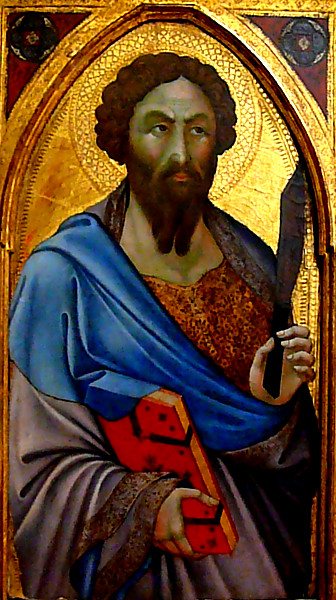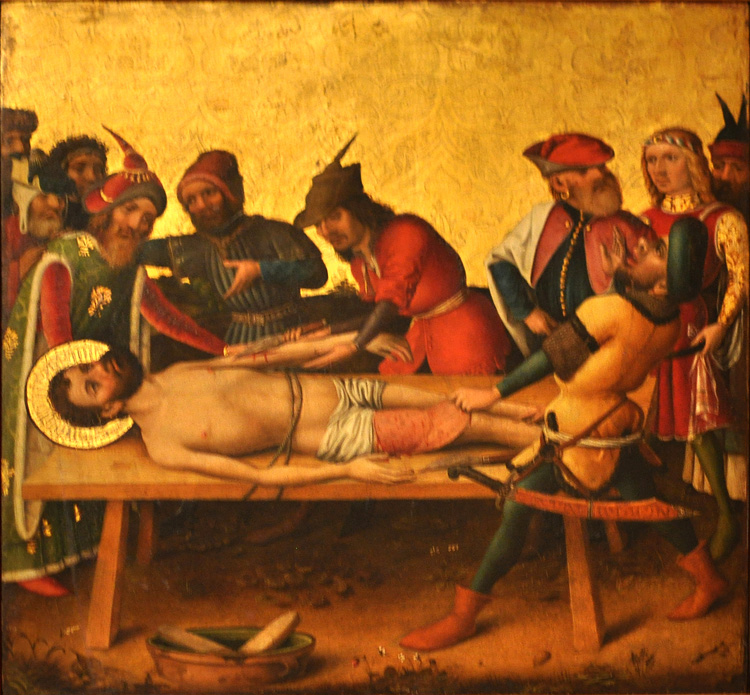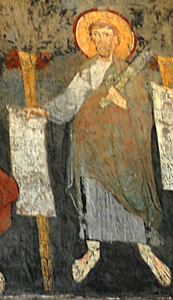NARRATIVE IMAGES
Many sources say that St. Bartholomew died by flaying and this is what we see in the second picture at right and in most images of his martyrdom. A painting of Ribera's in the Prado has the executioners prepare for the flaying by hoisting up a horizontal bar to which the saint's hands are tied. A possibly contemporaneous painting in Burgos Cathedral shows the next step: Bartholomew hangs from the crossbar while a man starts flaying his left arm.
Other sources say that the saint was beheaded, or that he was crucified.1 Some later images combine crucifixion with flaying by picturing the horizontal bar as a tree shaped like a cross (example). Or an artist can follow the suggestion in the Golden Legend and have the saint flayed and then crucified or beheaded (or both). One French illumination from the 14th century, for example, uses two side-by-side panels – the flaying on the left and the beheading (of the flayed saint) on the right.
PORTRAITS
Portraits usually show St. Bartholomew with a book and flaying knife, as in the first picture at right and in this stained glass. Sometimes he is instead portrayed skinless (example) or standing with his book in hand and a black demon chained (Astaruth) at his feet (example). Orthodox images normally use a scroll rather than a book (example).
The Golden Legend describes St. Bartholomew as having black curly hair, large eyes, fair skin, and a long beard starting to gray. Of these features the only one followed consistently in the images is the curly hair, and that only in Western images after the Legend was published, in the 13th century.
Prepared in 2015 by Richard Stracke, Emeritus Professor of English, Augusta University. Revised 2018-04-02.
HOME PAGE

Bartolomeo Bulgarini. St. Bartholomew, 14th century (See description page)

The flaying of St. Bartholomew (See description page)

St. Bartholomew in a detail from a fresco of six apostles at St. Paul Outside the Walls, possibly 11th or 12th century (See description page)
ATTRIBUTES
- Flaying knife
- Monster under feet
- Book in hand
MORE IMAGES
- 12th century: Double columns with sculptures of Saints Thomas and Bartholomew.
- 1264-90: Fresco placing the flaying alongside the beheading.
- First half of the 14th century: A statue of St. Bartholomew from a Verona church.
- 1315-20: Stained glass panel of the flaying.
- 1371: On the right in Giovanni Bonsi's Madonna Enthroned with Saints
- 1475-80: The saint is pictured in the lower register of a composite stained glass window from England.
- 1722: The saint is flayed in Tiepolo's Martyrdom of St. Bartholomew, apparently after having been hung on a cross.
- 1753-55: Statue of St. Bartholomew dressed and intact but holding his flayed skin.
- Circa 1753-62: Statue of St. Bartholomew above a relief picturing his martyrdom.
DATES
- Feast day: August 24
BIOGRAPHY
- Golden Legend #123: html or pdf
- Martyrdom of the Holy and Glorious Apostle Bartholomew, In Schaff, vol. 8.
- "Vita Sancti Bartholomei" [English text with Latin title], The Early South English Legendary, 366-76.
- Bartholomew's vita in The Roman Breviary: English translation, III, 853; Latin original, 1008-1010
- Acta Sanctorum, July vol. 5, 7-108
- pseudo-Abdias, 410-421
ALSO SEE
- The Apostles as a group
NOTES
1 Acta Sanctorum, August vol. 5, pp. 7-108. For a discussion of the various accounts of the saint's death, see especially pages 27-30.